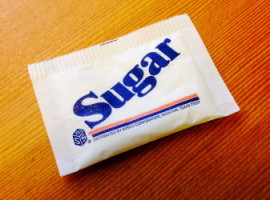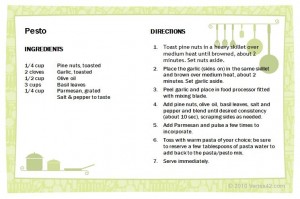 As I sit here writing this blog entry, I am mindlessly eating a raspberry yogurt and drinking coffee sweetened with soy creamer. It’s only 7:30 in the morning and I’ve already consumed 32 grams (or 8 teaspoons) of sugar.
As I sit here writing this blog entry, I am mindlessly eating a raspberry yogurt and drinking coffee sweetened with soy creamer. It’s only 7:30 in the morning and I’ve already consumed 32 grams (or 8 teaspoons) of sugar.
Not the healthiest way to start the day, especially since poor diet is a major contributor to the development of chronic diseases including heart disease, diabetes and cancer.
It’s no surprise that we have an obesity epidemic on our hands when sugar has made its way from scarce condiment to dietary staple. In the 1820s, annual U.S. sugar consumption was 20 pounds per adult. Today we gulp down 130 pounds of the stuff per person. That’s 22 teaspoons of added sugar every day! Children consume even more: 32 teaspoons of added sugar daily. And sugar is calorie-rich and nutrient poor.
How did our sugar consumption rise so rapidly?
In the 1970s, a number of studies appeared linking fat and cholesterol intake to heart disease and premature death. Ironically, the strength of this link has now been called into question. Back then, consumers were encouraged to replace fats and proteins with carbohydrates.
This was not a misguided recommendation. A low-fat, high complex carbohydrate diet is perfectly healthy, as reflected in the new USDA Choose My Plate recommendations. But complex carbohydrates — vegetables, fruits, and whole grains — are best consumed in their natural state, which produces much less profit for the food industry.
So food companies found a way to twist this new advice to their favor. They took less nutritious, cheap, processed carbohydrates like sugars, flours, and starches, turned them into more expensive things like SnackWells, and then pitched them as healthy, low-fat, low-cholesterol snacks.
Trouble is, these processed carbohydrates are a far cry from the complex carbohydrates originally recommended. Packaged foods are usually higher in sugar and salt, more easily digested (translation: don’t fill you up), and lack many of the micronutrients present in less processed food.
Then in the 1980s, high fructose corn syrup (HFCS) came onto the market. Now the food industry had a sweetener that was inexpensive, shelf-stable, and offered the advantage of making processed food moister. HFCS quickly became ubiquitous in our food supply.
Do a quick search of the Internet and you’ll find HFCS being blamed for everything from the obesity epidemic to autism to pancreatic cancer. Is high fructose corn syrup more harmful to the body than other sugars? There is simply no evidence in human studies that consumption of HFCS in normal amounts is any worse for you than other sugars.
What about the fructose in fruit? The amount of fructose consumed this way is such a small part of total sugar intake as to be negligible. So eat all the fruit you want. The real harm appears to come from the sheer quantity of sugar we are consuming.
Our natural craving for sweet foods worked well in an environment where sugar was rare and food was scarce. Sweets were caloric gold that could supply our bodies with energy when there was little else to eat.
But we live in a much different world now — with food outlets on every corner. Unfortunately, our biology has not changed much (evolution works slowly) and those same instincts now work against us. For example, eating sugar-sweetened foods still activates the reward centers in our brain, making sugar highly addictive. A recent study showed that when given a choice, rats preferred sugar-sweetened water over cocaine!
Armed with this knowledge, you can adjust your diet to avoid getting unneeded calories and curb your sugar intake.
Here are some tips for the next time you sit down to dine:
- Cut out sweetened drinks like sodas, iced teas, sports and energy drinks. Stick with water. Avoid fruit juice, too: even “100% juice” is still very high in sugar.
- What about alcohol? Wine and liquor are low in sugar, but high in calories. If weight loss is your goal, then cut out alcohol. And of course, drinking in moderation is best for your health (no more than one drink for women and two drinks for men per day).
- Avoid processed foods – eat foods as close to their natural forms as possible. (Example: whole nuts instead of nut butters.) The only exception to this would be frozen fruits and vegetables, which are equivalent or better than fresh in terms of nutritional value.
- Switch to whole grains. Eliminate white bread, white rice, and white pasta.
- Try making your own salad dressings and sauces. You’ll use less sugar and salt than packaged brands. And most sauces freeze well, so you can store them up. (We’ve been putting away basil pesto for the winter.)

- Switch to plain yogurt. Add fresh fruit, nuts and a small amount of sweetener if needed.
- Limit your intake of baked goods and sweets. These are treats to indulge in every so often, not every day.
- Skip the artificial sweeteners. Although these don’t contain sugar, you are still giving your body a sweet flavor (which triggers the reward center in your brain) and leads to more cravings.
Too long of a list? Pick just one to work on — it doesn’t matter much (though my personal recommendation would be the sweetened drinks). I’ll be joining you in your quest… just as soon as I finish my coffee.

